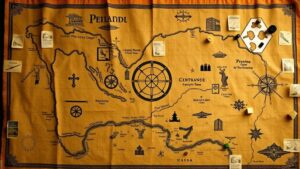Understanding Animal Motifs in Maps Used to Locate Ritual Treasure Sites
Understanding Animal Motifs in Maps Used to Locate Ritual Treasure Sites
Animal motifs have served a fundamental role in various cultural artifacts, including maps that are used to pinpoint ritual treasure sites. These motifs often transcend mere symbolic representation, encapsulating the beliefs, social structures, and spiritual ideologies of the cultures that produce them. This article explores the significance of animal motifs in treasure maps, addressing their historical context, interpretations, and implications for archaeology and cultural studies.
The Historical Context of Animal Motifs
Throughout history, different cultures have utilized animal symbols to convey meanings that resonate within their societal frameworks. For example, the ancient Egyptians extensively employed animal motifs, with deities like Anubis (the jackal) and Horus (the falcon) representing protection, guidance, and divine authority. These symbols often found their way into religious artifacts and, occasionally, into cartographic representations related to treasure discovery.
In medieval Europe, heraldry became a prominent avenue for the use of animal motifs. Families and knights adopted animal symbols in their crests, which could indicate lineage and territorial claims. When maps emerged during the Middle Ages to guide treasure seekers, they often incorporated these heraldic animals as a means of marking ownership over lands and resources associated with these treasures.
Maps that utilize animal motifs are often layered in meaning. They can embody a range of interpretations based on cultural beliefs regarding the animals portrayed. For example, in many indigenous North American cultures, the bear symbolizes strength and courage and is often represented on maps to denote a sacred treasure site. Rituals might be associated with these sites, where offerings would be made to the spirit of the bear in hopes of gaining favor in locating treasure.
A pertinent example of this occurs within the Navajo culture, where the coyote plays a critical role in the creation myths. Treasure maps integrated with coyote motifs often reflect the duality of the animal as a trickster, implying that seekers may need to navigate through deception or challenges to locate their prize.
Case Studies: Ritual Treasure Sites and Their Maps
One illustrative case study is the treasure maps of the Aztec civilization, which often included detailed motifs of various animals, such as the eagle. The eagle, significant in Aztec mythology, represents the sun and power. Maps leading to treasure associated with imperial offerings often depicted the eagle either as a guide or as a territorial marker of wealth. Researchers have found that these maps revealed not only the geography of the sites but also the socio-political landscape of Aztec society.
Another fascinating example comes from the maps used by the Vikings, known for their intricate carvings and dragon motifs. These symbols not only indicated treasures but also served as talismans of protection on voyages. Archaeological finds in significant Viking sites have shown a correlation between such motifs and treasure locations, suggesting a deep-rooted connection between the motifs and the Vikings’ cosmology.
Implications for Archaeological Research
The examination of animal motifs provides invaluable insights for archaeologists and cultural historians. By decoding these symbols, researchers can unlock a treasure trove of information regarding the socio-religious contexts in which these maps were created. An anthropological perspective can reveal how these motifs shaped behavior and belief systems centered around treasure hunting.
Also, contemporary advancements in geographical information systems (GIS) allow archaeologists to overlay historical maps with current geographical data. This blending of information not only aids in pinpointing potential treasure sites but also in understanding the ancient belief systems that prioritized certain locations as sacred or treasurable.
Conclusion and Actionable Takeaways
Understanding animal motifs in maps used to locate ritual treasure sites augments our comprehension of the historical and cultural narratives that surround these artifacts. By appreciating the depth of symbolism and meanings imbued in these motifs, scholars and enthusiasts alike can better appreciate the cultural landscapes these maps represent.
- Always analyze the cultural context of animal motifs when studying maps.
- Use multidisciplinary approaches–combining archaeology, anthropology, and history–for a comprehensive understanding.
- Incorporate modern technology such as GIS to uncover hidden truths behind ancient maps.
This exploration into animal motifs enriches not only academic discourse but also practical applications in modern treasure hunting and preservation of cultural heritage.


